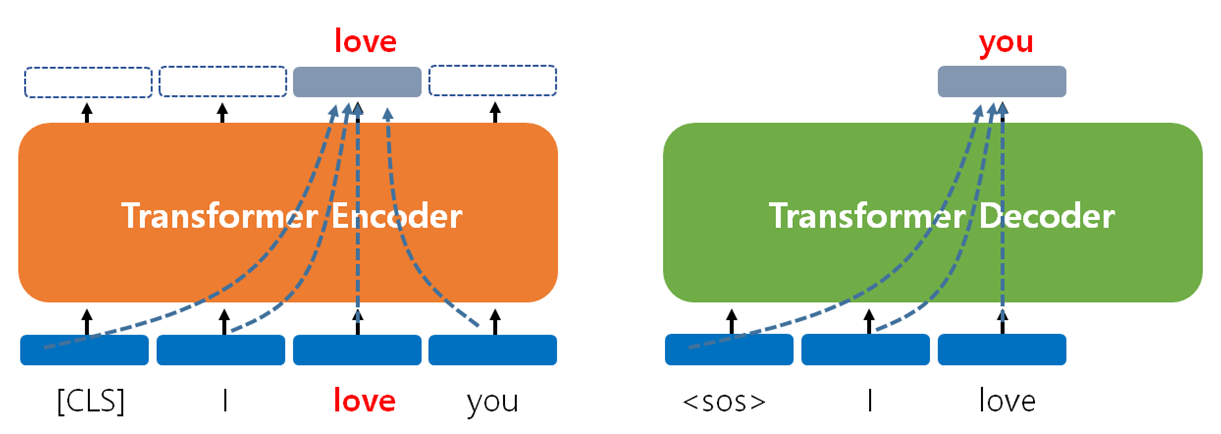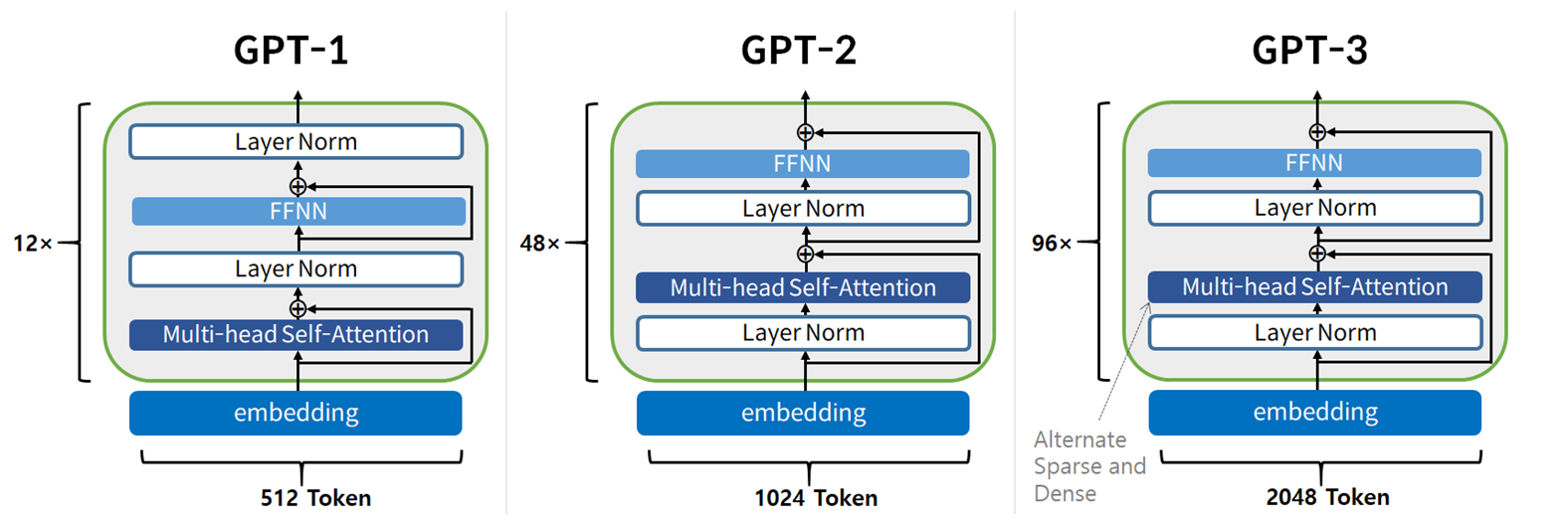GPT
Based on the lecture “Text Analytics (2024-1)” by Prof. Je Hyuk Lee, Dept. of Data Science, The Grad. School, Kookmin Univ.
GPT
-
지피티(
GenerativePre-trainedTransformer; GPT) : 트랜스포머의 디코더 아키텍처를 기반으로 하여 다양한 텍스트 데이터로 사전 훈련된 자기회귀모형(Auto-Regressive Model)-
자기회귀모형(
\[\begin{aligned} X_{t} &= \beta + \sum_{i=1}^{p}{\alpha_{i} \cdot X_{t-i}} + \epsilon_{t} \end{aligned}\]Auto-Regressive Model; AR) : 이전 출력값들을 참고하여 다음 출력값을 예측하는 모형- \(X_{t}\) : 현재 시점 출력값
- \(X_{t-i}\) : 이전 시점 출력값
- \(\alpha_{i}\) : 각 시점에 대한 가중치
- \(\beta\) : 편향
- \(\epsilon_{t}\) : 노이즈
-
-
vs. BERT
BERT GPT Type MaskedLanguageModelAuto-Regressive ModelTask NaturalLanguageUnderstandingNaturalLanguageGenerationObject Predict Masked Word Predict Next Word Direction Bidirectional Unidirectional Transformer Encoder Decoder -
Version
GPT-1 GPT-2 GPT-3 Year 2018 2019 2020 Embedding Dimension 768 1,024 12,288 Decoder Layers 12 48 96 Attention Heads 12 16 96 Total Parameters 117M 1.5B~15B 175B Traning Data BooksCorpus OpenWebText Common Crawl
WebText2
Wikipedia
BooksCorpus
Word Representation
-
Unique(or Max) Number of Vector
VECTOR GPT-1 GPT-2 GPT-3 Unique Tokens 40,000 50,257 50,257 Max Seq 512 1,024 2,048 - Tokenization Method : BPE(
Byte-PairEncoding)-
단어를 문자(Byte) 단위로 쪼갠 후 가장 많이 등장하는 문자 쌍(Pair)을 병합하는 과정을 반복하여 최종 내부 단어(Sub-Word) 단위 토큰을 생성함
-
Split a Word into Bytes
Word Bytes low [ l,o,w]lower [ l,o,w,e,r]newest [ n,e,w,e,s,t]widest [ w,i,d,e,s,t] -
Merge Pairs
Pair Count Merge ( l,o)2 lo( o,w)2 ow( e,s)2 es( s,t)2 st$\vdots$ $\vdots$ $\vdots$ -
Result
Word Sub-Word Tokens low [ lo,w]lower [ lo,w,er]newest [ ne,w,est]widest [ wi,d,est]
-
-
Embedding
\[\begin{aligned} \mathbf{x}_{i} &= \\mathbf{x}^{(i)}_{\text{TOKEN}} + \mathbf{x}^{(i)}_{\text{POS}} \end{aligned}\]-
\(\mathbf{x}^{(i)}_{\text{TOKEN}}\) : Token Embedding
-
\(\mathbf{x}^{(i)}_{\text{POS}}\) : Position Embedding, Not Fixed But Learnable
-
Single Layer
\[\begin{aligned} \mathcal{X}^{(0)} &=\text{Embeddings}\left(\text{Tokens}\right)\\ \mathcal{H}^{(k)} &=\text{Layer-Norm}\Big[\text{Multi-Head}\left(\mathcal{X}^{(k)};\mathcal{M}\right) + \mathcal{X}^{(k)}\Big]\\ \mathcal{Y}^{(k)} &=\text{Layer-Norm}\Big[\text{FFN}\left(\mathcal{H}^{(k)}\right) + \mathcal{H}^{(k)}\Big] \end{aligned}\]
- $\mathcal{X}$ is Input Data of Single Layer, $\mathcal{Y}$ is Output Data of Single Layer
- \(\mathcal{X}^{(k+1)}=\mathcal{Y}^{(k)}\) : Input Data of $k+1$ Decoder Layer is Output Data of $k$
- Input Data of Initial Layer \(\mathcal{X}^{(0)}\) is Sum of Token Embedding & Position Embedding Vector
- Output Data of Final Layer \(\mathcal{Z}=\mathcal{Y}^{(K)}\) is Output of Decoder Module
-
\(\text{Multi-Head}\left(\mathcal{X}^{(k)};\mathcal{M}\right)\) : Multi-Head Masked Self Attention
- $\mathcal{M}$ : Causal Mask(Upper-triangular mask)
-
\(\text{FFN}\left(\mathcal{H}^{(k)}\right)\) :
\[\begin{aligned} \text{FFN}\left(\mathcal{H}^{(k)}\right) &=\mathbf{W}^{(k)}_{2} \cdot \left(\text{ReLU}\left[\mathbf{W}^{(k)}_{1} \cdot \mathcal{H}^{(k)} + \mathbf{b}^{(k)}_{1}\right]\right) + \mathbf{b}^{(k)}_{2} \end{aligned}\]Feed-ForwardNetworks- $\mathbf{W}^{(k)}_{1} \in \mathbb{R}^{M \times 4d}$ : Dimension Expansion to four times the Dimension of the Embedding Vector
- $\mathbf{W}^{(k)}_{2} \in \mathbb{R}^{M \times d}$ : Dimension Reduction to Embedding Vector Dimension
Sourse
- https://wikidocs.net/184363



